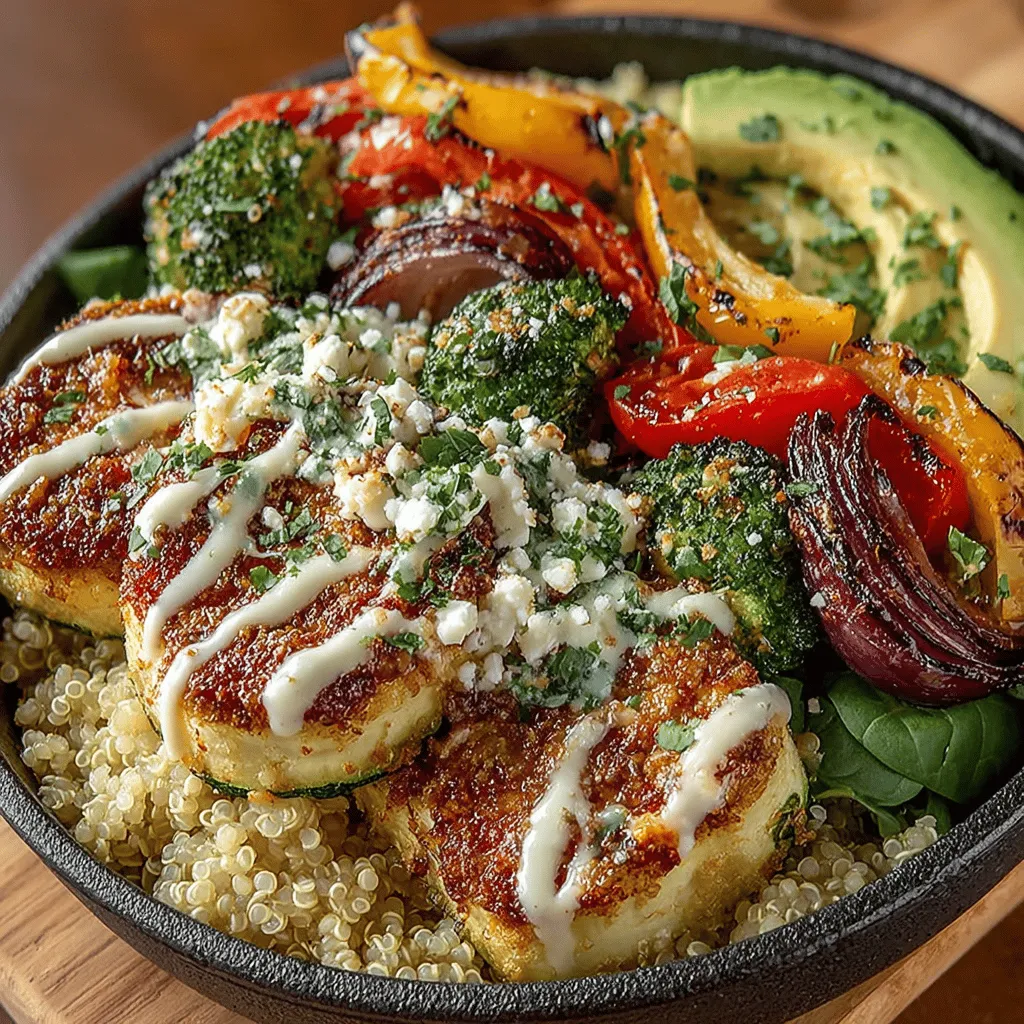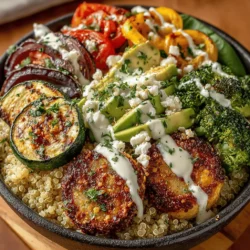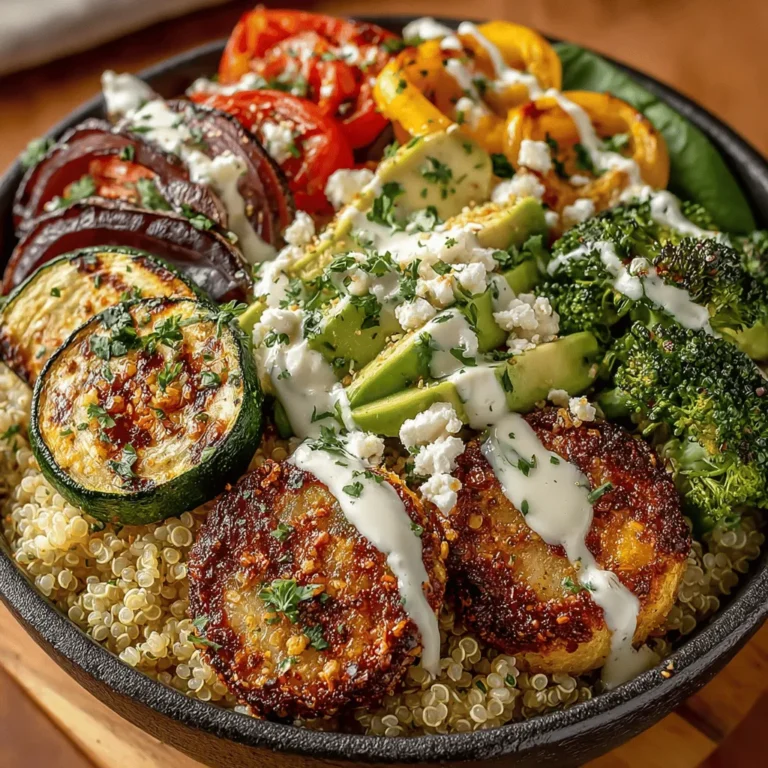In recent years, the trend towards healthy eating and plant-based diets has gained significant momentum. Among the many meal options available, power bowls have emerged as a favorite for their ability to combine various nutritious ingredients into one satisfying dish. These versatile meals not only cater to the growing demand for wholesome eating but also offer endless possibilities for customization. At the core of our Quinoa and Roasted Veggie Power Bowls are two key components: quinoa and roasted vegetables. Together, they create a dish that’s not only delicious but also aligns with various dietary preferences, including vegan, vegetarian, and gluten-free diets.
Ingredients
– 1 cup quinoa
– 2 cups vegetable broth (or water)
– 1 medium zucchini, diced
– 1 red bell pepper, diced
– 1 red onion, diced
– 1 cup cherry tomatoes, halved
– 1 cup broccoli florets
– 2 tablespoons olive oil
– 1 teaspoon garlic powder
– 1 teaspoon smoked paprika
– Salt and pepper, to taste
– Fresh spinach or arugula, for serving
– Optional: crumbled feta cheese for topping
Instructions
1. Preheat your oven to 425°F (220°C).
2. Rinse the quinoa under cold water and drain.
3. In a saucepan, combine the quinoa and vegetable broth (or water). Bring to a boil, then reduce the heat to low, cover, and simmer for about 15 minutes or until the liquid is absorbed. Fluff with a fork and set aside.
4. On a large baking sheet, combine the diced zucchini, red bell pepper, red onion, cherry tomatoes, and broccoli florets.
5. Drizzle the vegetables with olive oil and sprinkle with garlic powder, smoked paprika, salt, and pepper. Toss to coat evenly.
6. Roast the vegetables in the preheated oven for 20-25 minutes, or until they are tender and slightly caramelized.
7. In a large bowl, combine the cooked quinoa and roasted vegetables. Mix well.
8. Serve warm over a bed of fresh spinach or arugula, and top with crumbled feta cheese if desired.
Understanding the Nutritional Benefits of Quinoa
Quinoa is often hailed as a superfood due to its impressive nutritional profile. It is a rich source of protein, fiber, and essential amino acids, making it an excellent choice for those looking to maintain a balanced diet. The high protein content of quinoa is particularly beneficial for vegetarians and vegans, as it provides a complete source of protein that includes all nine essential amino acids. Additionally, quinoa is gluten-free, making it suitable for individuals with gluten intolerance. Its consumption has been linked to various health benefits, including improved heart health and effective weight management.
Quinoa can be easily incorporated into a variety of meals beyond this power bowl recipe. It can be added to salads, soups, or even used as a base for grain bowls, offering flexibility and nutrition in every bite.
The Role of Roasted Vegetables in a Balanced Diet
The vegetables selected for this power bowl – zucchini, red bell pepper, red onion, cherry tomatoes, and broccoli – each contribute a unique set of nutrients. Zucchini is low in calories and rich in vitamins A and C, while red bell peppers provide a significant amount of beta-carotene and antioxidants. Red onions are known for their anti-inflammatory properties, and cherry tomatoes add a sweet burst of flavor along with lycopene, a powerful antioxidant. Broccoli, packed with vitamins K and C, is known for its cancer-fighting properties.
Roasting vegetables enhances their flavor and texture while retaining their nutrients. This cooking method caramelizes the natural sugars in the vegetables, resulting in a rich, savory taste. Moreover, using seasonal vegetables allows for variety and freshness in your power bowls, ensuring that each meal is both exciting and nutritious. Including a colorful array of vegetables not only makes the dish visually appealing but also ensures a wide range of vitamins and minerals in your diet.
Ingredient Breakdown for Quinoa and Roasted Veggie Power Bowls
Quinoa
Quinoa stands out as a nutritional powerhouse. It is not only high in protein but also contains a good amount of fiber, which aids in digestion and promotes satiety.
Vegetable Broth vs. Water
Using vegetable broth instead of water to cook quinoa adds depth of flavor to the grain, enhancing the overall taste of the dish.
Olive Oil
Olive oil is a heart-healthy fat that contributes to the flavor and promotes nutrient absorption. Its high smoke point makes it suitable for roasting vegetables.
Seasonings
Garlic powder and smoked paprika provide a delightful flavor boost, making the vegetables more appetizing without adding unnecessary calories.
Fresh Greens
Choosing between fresh spinach or arugula adds a layer of nutrition and flavor to the power bowl. Spinach is rich in iron, while arugula offers a peppery bite.
Feta Cheese
Adding crumbled feta cheese is optional, but it enhances the dish with a creamy texture and tangy flavor, making it even more satisfying.

Tahini Dressing: Nutritional Benefits and Alternatives
Tahini dressing is a creamy and flavorful addition to quinoa and roasted veggie power bowls. Rich in healthy fats, it provides a good source of protein, fiber, and essential minerals such as calcium and iron. However, if you’re looking for alternatives, consider options like tahini-free vinaigrettes made with olive oil and lemon juice, or yogurt-based dressings for a tangy twist. These alternatives can maintain the creamy texture while introducing unique flavors to your dish.
Step-by-Step Instructions for Preparing the Power Bowls
Preheating the Oven and Its Importance for Roasting
Preheating your oven is crucial for achieving perfectly roasted vegetables. A hot oven ensures that your veggies caramelize and develop a delicious golden-brown exterior while remaining tender inside. Aim to preheat your oven to 425°F (220°C) for optimal roasting results.
Detailed Instructions on Cooking Quinoa
To cook quinoa, start by rinsing it under cold water to remove its natural coating, called saponin, which can impart a bitter taste. Use a ratio of 1 part quinoa to 2 parts water or vegetable broth for added flavor. Bring the liquid to a boil, then reduce the heat, cover, and simmer for about 15 minutes, or until the grains are fluffy and the water is absorbed. For perfect texture, let it sit covered for 5 minutes off the heat before fluffing it with a fork.
Preparing and Seasoning Vegetables for Roasting
Choose a variety of seasonal vegetables such as bell peppers, zucchini, carrots, and broccoli. Cut them into uniform pieces to ensure even cooking. Toss the vegetables in olive oil, salt, pepper, and your choice of herbs or spices, such as garlic powder or smoked paprika, for added flavor.
Best Practices for Roasting Vegetables: Temperature, Time, and Stirring
Roast your seasoned vegetables at the preheated temperature of 425°F (220°C) for about 20-25 minutes. Halfway through the roasting time, stir the vegetables to promote even cooking and browning. They should be tender and caramelized when ready.
Assembling the Bowls with Visual Presentation Tips
To assemble your power bowls, start with a base of fluffy quinoa, then artfully arrange the roasted veggies on top. Drizzle with tahini dressing or your chosen alternative. Finish with garnishes like fresh herbs, seeds, or nuts for texture and color. A visually appealing bowl makes the meal more inviting and enjoyable.
Creative Variations and Customizations
Suggestions for Adding Protein
Enhance your power bowls by incorporating a protein source. Options include chickpeas for a plant-based choice, grilled chicken for meat lovers, or marinated tofu for a vegetarian alternative. Adding protein not only boosts the nutritional value but also keeps you satiated longer.
Ideas for Incorporating Different Vegetables Based on Seasonality
Make the most of seasonal produce by swapping out vegetables based on availability. In spring, use asparagus and peas; in summer, try corn and cherry tomatoes; and in fall, consider root vegetables like sweet potatoes and Brussels sprouts. This keeps the dish fresh and exciting.
Alternatives to Tahini Dressing for Flavor Diversity
For those who may not enjoy tahini, experiment with different dressings such as a lemon-tahini blend, balsamic vinaigrette, or a spicy yogurt sauce. Each alternative can bring a unique flavor profile to your power bowls and cater to diverse palates.
Options for Making the Dish Spicier or Adding Unique Flavor Profiles
If you crave heat, consider adding sliced jalapeños, a sprinkle of red pepper flakes, or a drizzle of sriracha to your bowl. Additionally, try incorporating unique spices like curry powder or za’atar to elevate the flavor and add an international twist.
Meal Prep and Storage Suggestions
Tips for Preparing the Dish in Advance
To streamline meal prep, batch-cook quinoa and roast a variety of vegetables at the start of the week. Store them separately in airtight containers for quick assembly during busy days. You can mix and match components to create different bowls throughout the week.
Best Practices for Storing Individual Components for Optimal Freshness
Keep cooked quinoa and roasted vegetables in the refrigerator for up to four days. To maintain freshness, store dressings separately and add them just before serving. This will prevent sogginess and keep flavors vibrant.
Guidance on Reheating the Bowls Without Compromising Flavor and Texture
When reheating, do so gently in the microwave or on the stovetop. Add a splash of water to the quinoa to prevent it from drying out. Heat the vegetables until warm but not overcooked, as this can affect their texture.
Final Thoughts on Quinoa and Roasted Veggie Power Bowls
Quinoa and roasted veggie power bowls are not only nutritious but also versatile. You can easily adapt the ingredients to suit your taste preferences and dietary needs. Enjoying these bowls can lead to a healthier lifestyle while allowing for creativity in the kitchen.
Conclusion
The rising interest in healthy and sustainable eating practices makes quinoa and roasted veggie power bowls an excellent choice for a balanced diet. By embracing whole foods and experimenting with different ingredients, you can create meals that nourish your body and delight your taste buds. Embrace the creativity of cooking and explore the endless possibilities for a healthier future.


